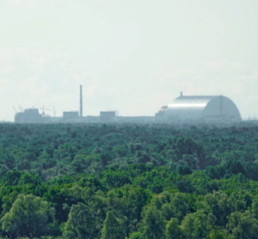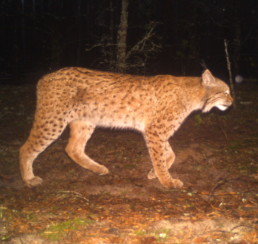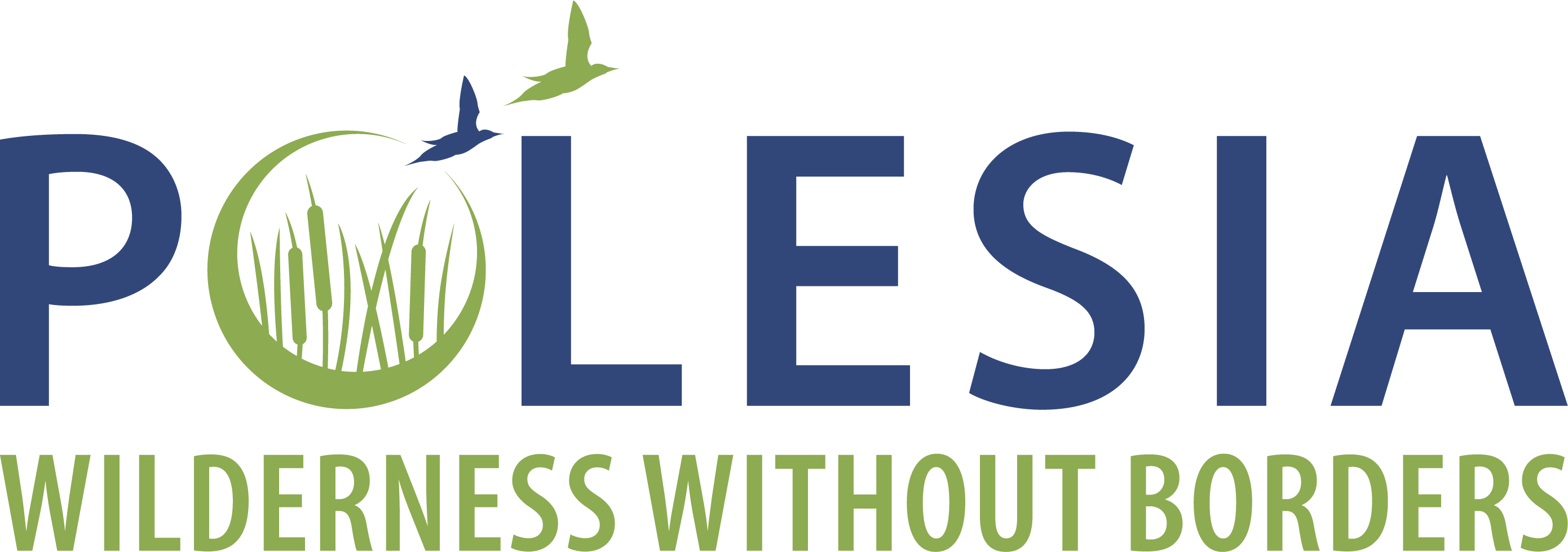Studies
The wilderness of Polesia is vast, diverse and in many ways unique. However, many of its aspects are still poorly understood. Research is therefore an important part of our project. We are studying the landscape of Polesia in all its diversity, the populations of key species and their habitats. We also focus on the threats to the nature of the region and ways to mitigate them. Scientific data allows us to target conservation activities and make them more efficient. It helps us lobby for additional protection for species and habitats, and for the designation and expansion of protected areas. Some of the studies carried out as part of the project are groundbreaking for Polesia and pave the way for further systematic and consistent research in this area of high conservation value.
Spatial and temporal differences in migration strategies among endangered European Greater Spotted Eagles Clanga clanga
The Greater Spotted Eagle is a globally threatened migratory bird of prey. About 20% of the continent’s population nests in Polesia, which boasts a high concentration of the nesting sites. Each year, Greater Spotted Eagles fly thousands of kilometres between their breeding and wintering ranges. The study, co-authored by researchers from the project, is based on tracking data from 28 Greater Spotted Eagles, including those from Polesia. It analyses the birds’ different migration strategies, possible threats they face during seasonal migration, and their wintering areas, which may need additional protection to prevent further decline of the rare species.
Väli, Ü., Dombrovski, V., Maciorowski, G., Sellis, U., & Ashton‐Butt, A. (2021). Spatial and temporal differences in migration strategies among endangered European Greater Spotted Eagles Clanga clanga. Bird Conservation International, 33. https://doi.org/10.1017/s0959270921000411


The level of water in the river flowing through the breeding site shapes the body condition of a lekking bird — the Great Snipe Gallinago media
Each spring, the floodplains of Polesia’s rivers provide nesting and feeding sites for thousands of wading birds, including the Great Snipe – one of the few lekking birds. During the mating season, the physical condition of the male birds depends on the availability of food, which in turn is influenced by the water level in the rivers during the spring flood. This is the conclusion drawn by the authors of the paper, which analyses the data collected over 20 years, from 2001 to 2020. The researchers emphasise that the natural water regime of free-flowing rivers is one of the factors that ensure the breeding success of wading birds, including the Great Snipe, whose conservation status is ‘near threatened’ due to declining populations.
Witkowska, M., Pinchuk, P., Meissner, W., Karlionova, N., & Marynkiewicz, Z. (2022). The level of water in the river flowing through the breeding site shapes the body condition of a lekking bird—the Great Snipe Gallinago media. Journal of Ornithology, 163(2), 385–394. https://doi.org/10.1007/s10336-022-01966-5
Long-term effects of rewilding on species composition: 22 years of raptor monitoring in the Chernobyl Exclusion Zone
After the catastrophic accident at the Chornobyl nuclear power plant in 1986, the surrounding areas, once densely populated, were abandoned by man. Thus an unprecedented experiment started in Polesia: nature began to restore itself and reclaim land without any guidance. The authors of the study found that the ongoing changes in the landscape of the Chornobyl Exclusion Zone, with an increasing proportion of forests and wetlands, are benefiting some rare bird species. For example, it is now the only place in the world where the globally threatened Greater Spotted Eagle is increasing in numbers.
Dombrovski, V., Zhurauliou, D., & Ashton‐Butt, A. (2022). Long‐term effects of rewilding on species composition: 22 years of raptor monitoring in the Chernobyl Exclusion Zone. Restoration Ecology, 30(8). https://doi.org/10.1111/rec.13633


Walking on the dark side: Anthropogenic factors limit suitable habitat for Grey wolf (Canis lupus) in a large natural area covering Belarus and Ukraine
The Grey wolf has never been eradicated from Polesia, although it is hunted throughout the year. To avoid anthropogenic pressure, wolves seek refuge in remote and inaccessible areas. The study supported by our project analyses habitat suitability for wolves in Polesia by correlating wolf presence data with indices of artificial light at night, proportion of cropland and tree cover. The authors found that wolves avoid areas with permanent human presence. About 26% of Polesia’s territory is suitable for the Grey wolf, but not all of these areas are occupied by the species due to habitat fragmentation. The study helps identify areas that could be protected to improve connectivity between core protected areas, which is crucial for wolf conservation.
Kudrenko, S., Vollering, J., Zedrosser, A., Selva, N., Ostapowicz, K., Fenchuk, V., Beasley, J. C., & Heurich, M. (2023). Walking on the dark side: Anthropogenic factors limit suitable habitat for gray wolf (Canis lupus) in a large natural area covering Belarus and Ukraine. Global Ecology and Conservation, 46, e02586. https://doi.org/10.1016/j.gecco.2023.e02586
Shining a light on elusive lynx: Density estimation of three Eurasian lynx populations in Ukraine and Belarus
Despite its high conservation importance, the populations of the Eurasian lynx in Polesia are still poorly understood. To fill this information gap, a large-scale camera trapping survey was carried out in the region in 2020-2021. This enabled the first scientifically based assessment of lynx densities in three protected areas, including the Ukrainian Chornobyl Exclusion Zone and three adjacent protected areas in the Belarusian Polesia. This work is groundbreaking for both Ukraine and Belarus, paving the way for further research into local Eurasian lynx populations and their effective conservation.
Palmero, S., Smith, A. F., Kudrenko, S., Gahbauer, M., Dachs, D., Weingarth‐Dachs, K., Kashpei, I., Shamovich, D., Vyshnevskiy, D., Борсук, О., Korepanova, K. D., Bashta, A., Zhuravchak, R., Fenchuk, V., & Heurich, M. (2023). Shining a light on elusive lynx: Density estimation of three Eurasian lynx populations in Ukraine and Belarus. Ecology and Evolution, 13(11). https://doi.org/10.1002/ece3.10688


Reduced human disturbance increases diurnal activity in wolves, but not Eurasian lynx
The coexistence of wildlife and people in Europe’s human-dominated landscape is a complex phenomenon. Protected areas are relatively small and they intermingle with areas of high human disturbance. This leads animals to use various adaptation mechanisms, including increasing their nocturnal activity. The recent study supported by our project analyses for the first time the diurnal activity of wolves and lynx along a gradient of human disturbance to reveal the correlation between anthropogenic pressure and animals’ temporal behavior.
Smith, Adam & Kasper, Katharina & Lazzeri, Lorenzo & Schulte, Michael & Kudrenko, Svitlana & Say-Sallaz, Elise & Churski, Marcin & Shamovich, Dmitry & Obrizan, Serhii & Domashevsky, Serhii & Korepanova, Kateryna & Bashta, Andriy-Taras & Zhuravchak, Rostyslav & Gahbauer, Martin & Pirga, Bartosz & Fenchuk, Viktar & Kusak, Josip & Ferretti, Francesco & Kuijper, D.P.J. & Heurich, Marco. (2024). Reduced human disturbance increases diurnal activity in wolves, but not Eurasian lynx. Global Ecology and Conservation. e02985. DOI:10.1016/j.gecco.2024.e02985
The first bespoke landcover map for Polesia
The first bespoke landcover map for the whole Polesia is a tool that enables dynamic monitoring of the landscape over seasons and longer periods. It also facilitates various environmental analyses, like dynamic monitoring of restoration or degradation of natural areas, changes in land use, and analyzing the intensity of seasonal floods. The tool can also be of use for assessing landscape connectivity, mapping species distribution, or protected areas enlargement.
The method implemented by authors of this landcover map can be adapted for a variety of landscapes, including those beyond Polesia.
Landscape fires and ecological restoration
The authors of the research used the global FRY database and cloud-based software to analyze 5,338 large fires that occurred in Polesia from 2001 to 2019. They mapped the seasonal distribution of large fires, identified the environmental and human drivers of fire size and occurrence with a particular focus on areas of high conservation importance. The researchers underline that maintaining and restoration of natural hydrological regimes in the area, primarily rewetting of degraded peatlands, is the most effective nature-based measure protecting carbon-storing ecosystems, assisting to biodiversity conservation and making the landscape more resilient to extensive fires.






